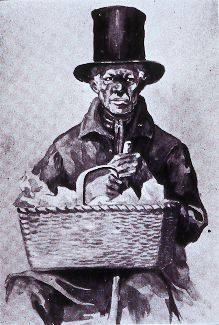William Grimes (ex-slave) facts for kids
William Grimes (1784 – August 20, 1865) was an African American barber and writer. He wrote what is thought to be the first story by an American ex-slave. This book was called Life of William Grimes, the Runaway Slave. It was first published in 1825. A second edition came out in 1855.
Grimes escaped slavery by hiding on a ship named Casket. This ship sailed from Savannah, Georgia to New York City. From New York, he walked to Connecticut to start his new life as a free man. He lived in several towns in Connecticut. These included Stratford, Norwalk, Fairfield, and Bridgeport. He also lived in New Haven and Litchfield. New Haven was where he finally settled down.
Contents
William Grimes's Early Life
William Grimes was born into slavery in King George County, Virginia, in 1784. His father was Benjamin Grymes, Jr., a rich plantation owner. William's mother was a slave on a nearby farm.
During his time as a slave, Grimes had at least ten different owners. He lived in Virginia, Maryland, and Georgia. He worked in many roles. He was a house servant, a valet, a field worker, a stable boy, and a coachman.
In 1815, when he was 30 years old, Grimes escaped slavery. He hid on the ship Casket. The ship sailed from Savannah, Georgia to New York City. After arriving in New York, he traveled on foot to New Haven, Connecticut.
Life as a Free Man
Grimes settled in New Haven, Connecticut. There, he became a successful barber. Many of his customers were students from nearby Yale University. Others came from Litchfield.
In 1817, William Grimes married Clarissa Caesar in New Haven. Reverend Samuel Merwin married them. They had eighteen children together. Sadly, only twelve of their children lived to be adults.
Grimes worked as a barber, a grocer, and a furniture seller. He lived in many different cities in Connecticut. These included Stratford, Norwalk, Fairfield, and Bridgeport. He also lived in New Haven and Litchfield.
Buying His Freedom
In 1823, Grimes's last slave owner found him. The owner demanded that Grimes pay for his freedom. If Grimes refused, he would be arrested and forced back into slavery. Grimes had to pay with "my house and land, all I had."
In April 1824, Grimes officially bought his freedom for $500. This was a lot of money back then. He had to mortgage his property and take on debt to pay. His friends in Litchfield helped him negotiate the price.
Grimes had no choice but to pay. He wrote his first book to try and earn back his money. He moved back to New Haven after buying his freedom. He lived there for the rest of his life. His wife, Clarissa Caesar, later moved to California.
His Family's Legacy
Regina Mason is a great-great-great-granddaughter of William Grimes. She helped edit a new version of Grimes's book in 2008. Mason shared her ancestor's story in an interview in 2016.
A film called Gina's Journey: The Search for William Grimes was made in 2017. It shows Regina Mason's fifteen-year search for information about Grimes. The film includes scenes from both their lives.
Death and Burial
William Grimes died on August 20, 1865. He was about 81 years old. He passed away in New Haven, Connecticut. News of his death was even printed in newspapers as far away as Brooklyn, New York.
He was buried in Grove Street Cemetery. This cemetery is located near Yale University. His wife, Clarissa Caesar Grimes, died later in San Francisco. She was then buried next to him in New Haven.
His Famous Books
Life of William Grimes, the Runaway Slave
William Grimes published his first book, Life of William Grimes, the Runaway Slave, in 1825. He wrote it to help pay off his debts. This book tells the detailed story of his life up to 1825. It was published only a few months after he bought his freedom.
Grimes also published an updated version of his autobiography in 1855. He felt his first book, being the first of its kind, did not earn him enough money. The second book updated his life story until 1855. It also had a less bitter tone than his first book. However, the second book did not get as much attention as the first.
Images for kids



